Cirrhosis and Its Link to Liver Cancer
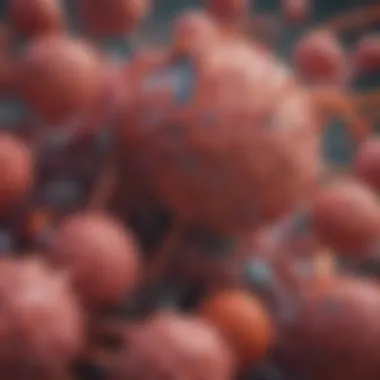

Intro
Cirrhosis has a reputation as a silent predator, quietly transforming healthy liver tissue into fibrous scar tissue over time. As this condition develops, it sets the stage for one of the most alarming potential outcomes: liver cancer. Understanding this intricate relationship becomes essential for healthcare professionals and patients alike, especially considering the rise of liver-related illnesses across the globe.
What’s particularly concerning is how common cirrhosis can be. Factors such as chronic viral hepatitis and heavy alcohol use are rampant in many populations. Unlike some other chronic diseases, many individuals live with cirrhosis without realizing the grave implications it can entail, particularly its connection to liver malignancies. So, what exactly happens at a biological level, and why should we pay close attention?
This exploration will journey through the various mechanisms at play, unearthing the critical underpinnings that link cirrhosis to liver cancer. The aim is not merely to highlight the harsh realities but also to foster a proactive approach among patients and clinicians. Monitoring cirrhosis closely can indeed make a world of difference in managing and potentially preventing the cascade toward cancer.
Research Overview
Summary of Key Findings
Research over the years has established strong correlations between cirrhosis and liver cancer, particularly hepatocellular carcinoma (HCC). Studies indicate that about 80% of HCC cases occur in individuals with underlying cirrhosis. Here are some key findings:
- Cirrhosis results in increased liver cell turnover, which can lead to mutagenic events and eventually malignancy.
- Chronic inflammation from liver diseases such as hepatitis B or C is associated with significant risk; inflammation sets the stage for oxidative stress, which fuels tumorigenesis.
- Fibrosis, an early sign of cirrhosis, is often a precursor condition that increases the risk of HCC developing over time.
Relevance to Current Scientific Discussions
In modern healthcare discussions, cirrhosis and its implications are at the forefront, especially in public health contexts. With the increasing prevalence of obesity and metabolic syndrome, there's a new wave of non-alcoholic fatty liver disease (NAFLD) contributing to cirrhosis and its potential progression to cancer. Given this, the conversation is shifting toward greater awareness of cirrhosis and the need for screening strategies that can catch precursors early, before they escalate to cancer.
"Recognizing cirrhosis as not just a standalone condition but a doorway to more serious liver diseases is critical in today's clinical practice."
As global health initiatives focus on reducing the burden of liver disease, understanding the nuances between cirrhosis and liver cancer becomes pivotal in shaping effective prevention and treatment strategies.
Methodology
Research Design and Approach
To understand the depth of the cirrhosis-cancer nexus, researchers often employ longitudinal studies that observe patient outcomes over significant periods. Surveys and retrospective analyses shed light on patient histories, risk factors, and developments via clinical databases. Employing a mixture of both observational and interventional research allows for a more comprehensive understanding.
Data Collection and Analysis Techniques
Researchers glean insights from various healthcare settings, often combining findings from hospitals, specialized clinics, and national health registries. These studies frequently utilize:
- Epidemiological studies to map the prevalence rates of cirrhosis developing into liver cancer.
- Histopathological examinations to identify cellular changes in liver biopsies.
- Surveys from healthcare providers to assess awareness and monitoring practices among cirrhosis patients.
With these methodologies, the research paints a clearer picture, highlighting not just the occurrence of liver cancer among cirrhotic patients but also the complexities that intertwine these two serious conditions.
Understanding Cirrhosis
Cirrhosis is much more than a medical term tossed around at doctors' offices; it’s the culmination of chronic liver damage and often the stepping stone to more dire conditions like liver cancer. Understanding cirrhosis is key to grasping the overall landscape of liver health and disease. It lays the foundation for discussing prevention, diagnosis, and treatment options, making it relevant not just for healthcare professionals but for anyone concerned about liver health.
Definition and Overview
Cirrhosis refers to the scarring of the liver resulting from long-term, continuous damage. The liver, being a vital organ responsible for detoxifying harmful substances, producing bile, and facilitating digestion, becomes increasingly compromised as cirrhosis progresses. Patients often wonder why some casual drinking or unchecked viral infections can lead to such severe consequences. The journey from a healthy liver to one affected by cirrhosis underscores multiple pathways through which liver integrity can falter.
Pathophysiology of Cirrhosis
At its core, cirrhosis involves a cycle of injury and healing. When the liver sustains damage, the body responds by attempting to repair it. However, this repair process results in scar tissue formation, disrupting the normal architecture of the liver. As the scars accumulate, liver function deteriorates, leading to complications such as portal hypertension and liver failure. Here, it might sound like a never-ending loop where the more the damage is inflicted, the more the body tries to mend itself but only ends up worsening the situation. Getting familiar with this pathophysiological progression can help break down why cirrhosis elevates the risk for conditions like liver cancer.
Causes of Cirrhosis
Understanding the root cause of cirrhosis is essential. Here’s a closer look at several primary culprits that can lead to this condition:
Viral Infections
Viral infections, notably hepatitis B and C, play a massive role in developing cirrhosis. Both viruses affect liver cells, leading to inflammation and, over time, scarring. One notable aspect is how silently these infections can progress—often, by the time one experiences symptoms, significant damage has already occurred. This characteristic highlights why screening is crucial, especially for those at risk.
Alcohol Overconsumption
The phrase "too much of a good thing" rings true regarding alcohol. Regular heavy drinking can cause liver cells to die, leading to inflammation and scarring. This aspect of cirrhosis is particularly relevant in conversations surrounding societal attitudes towards alcohol use. Many see drinking as a social activity, but its health implications can’t be ignored. Understanding why alcohol is a significant risk factor for cirrhosis helps frame discussions about responsible drinking.
Non-Alcoholic Fatty Liver Disease
Non-Alcoholic Fatty Liver Disease (NAFLD) has emerged as a red flag in recent years—primarily due to the increasing prevalence of obesity. Unlike cirrhosis arising from alcohol, NAFLD occurs in individuals who drink little to no alcohol. Fat builds up in the liver, potentially leading to inflammation and cirrhosis. This feature makes NAFLD particularly concerning in a world where diet and lifestyle choices are often overlooked. The trade-off between our modern eating habits and liver health can’t be overstated, making NAFLD a vital area for public health awareness.
Autoimmune Conditions
Certain autoimmune conditions, such as autoimmune hepatitis, pose another pathway to cirrhosis. Here, the body mistakenly attacks its own liver cells, resulting in inflammation and scar tissue formation. The irony lies in the immune system’s attempt to protect the body, ultimately leading to self-inflicted harm. This unique aspect underscores the complexity of liver disease management, making awareness of autoimmune conditions valuable for healthcare providers.
Genetic Disorders
Finally, some genetic disorders, like Wilson's disease or hemochromatosis, exacerbate liver health issues. These conditions result in the accumulation of copper or iron in the liver, which contributes to cirrhosis over time. Understanding these genetic underpinnings can provide critical insights into why certain individuals are more susceptible to liver disease, aiding in both diagnosis and treatment strategies.
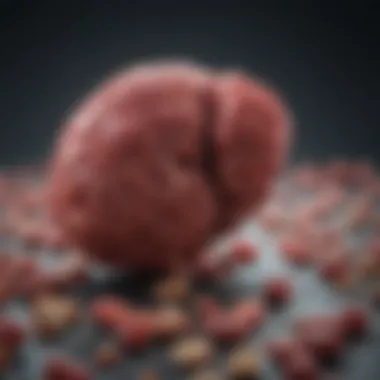
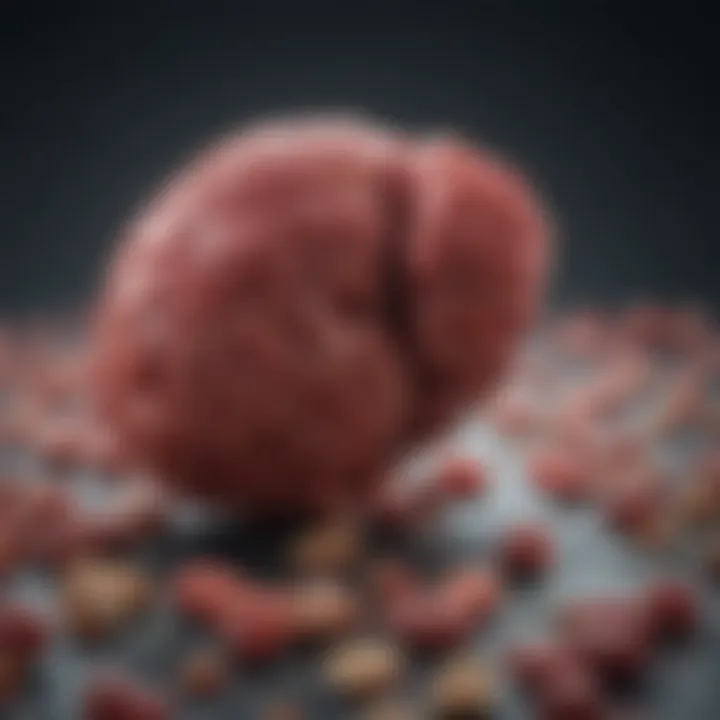
Symptoms of Cirrhosis
Symptoms of cirrhosis can vary, and some patients may experience none at all until the disease is quite advanced. Common signs include fatigue, jaundice, and swelling in the legs and abdomen. Often, the late discovery of these symptoms leads to a harsher prognosis. Being aware of these symptoms encourages proactive health management and timely clinical intervention.
Liver Cancer: An Overview
Understanding liver cancer is crucial because it sheds light on how cirrhosis paves the way for this grave condition. Liver cancer, particularly Hepatocellular Carcinoma, is not merely a result of mere cellular aberration but rather stems from a long-standing liver condition that often begins with cirrhosis. The targeted examination of liver cancer within the context of cirrhosis provides healthcare professionals and patients alike with insights into preventive measures and treatment options. By identifying the various types of liver cancer and their relationship with cirrhosis, we can equip ourselves with knowledge crucial for effective clinical discussions and patient care.
Definition of Liver Cancer
Liver cancer refers to malignant tumors that arise in the liver tissue. The most prevalent type is Hepatocellular Carcinoma, which originates in the liver cells. There are also other forms such as Cholangiocarcinoma, arising from bile ducts, and metastatic liver cancer, which occurs when cancer from other body parts spreads to the liver. This cancer often develops slowly over time, and what makes it particularly insidious is its capacity to remain undetected until it reaches advanced stages, frequently in conjunction with pre-existing liver conditions.
Types of Liver Cancer
Hepatocellular Carcinoma
Hepatocellular Carcinoma, or HCC, is the most common form of liver cancer. It generally arises in individuals with chronic liver diseases, particularly those with cirrhosis stemming from hepatitis infections or alcohol abuse.
- Key characteristic: HCC is notorious for being asymptomatic in its early stages. Symptoms might not surface until it’s more advanced, making early diagnosis quite challenging.
- Unique feature: This type of cancer is often associated with underlying cirrhosis, enhancing its relevance in discussions about liver health.
- Advantages: Focusing on HCC allows for an exploration into preventive strategies that can be adopted by those with liver conditions. Recognizing its association with cirrhosis is pivotal for timely screenings and interventions to enhance patient outcomes.
Cholangiocarcinoma
Cholangiocarcinoma is another type of liver cancer, but it engulfs the bile ducts—either within the liver or outside. It is relatively less common than HCC but remains dangerous nonetheless.
- Key characteristic: Cholangiocarcinoma can present symptoms like jaundice, itching, and abdominal pain, which can often lead to earlier diagnoses compared to HCC.
- Unique feature: Its distinct pathway of origin means it requires different treatment considerations and approaches.
- Advantages: While not as prevalent, discussing Cholangiocarcinoma is important to understand how different types of liver cancers can have varied presentations and outcomes, especially in cirrhotic patients.
Liver Metastases
Liver metastases refer to cancer that has spread to the liver from another part of the body. This form is considered secondary cancer within the liver and is typically more common than primary liver cancers.
- Key characteristic: Metastatic cancer indicates the progression of a primary cancer, which may signal advanced disease that requires tailored treatment strategies.
- Unique feature: Unlike HCC, metastatic liver cancer demands an understanding of the primary tumor's origin, which often dictates the treatment plan.
- Advantages: It is essential to encompass liver metastases in this discussion as it emphasizes the need for comprehensive evaluations in patients with known cancers, particularly those at higher risk due to cirrhosis.
Epidemiology of Liver Cancer
The epidemiology of liver cancer highlights its global prevalence, noting that factors like viral infections, obesity, and alcohol consumption significantly impact rates. Understanding these patterns can aid in developing targeted prevention strategies and enhancing screening practices for at-risk populations.
Cirrhosis as a Risk Factor for Liver Cancer
The connection between cirrhosis and liver cancer is not a casual relationship; it’s a profound association that merits close scrutiny. Cirrhosis serves as a crucial indicator in the clinical landscape, representing a significant turning point in liver disease that can lead to the emergence of malignancy. Comprehending this relationship is essential for healthcare professionals and patients alike, as it provides insights into disease progression and lays the groundwork for preventative measures.
Understanding how cirrhosis elevates the risk of liver cancer is fundamental. An intricate web of factors comes into play, from the underlying conditions that cause cirrhosis to the biological changes that ensue. In essence, cirrhosis marks not just the liver’s deterioration, but also a stark signal that vigilance is needed to fend off the threat of cancer.
Mechanisms Linking Cirrhosis and Liver Cancer
Chronic Inflammation
Chronic inflammation is at the heart of many pathological processes, including the journey from cirrhosis to liver cancer. When the liver experiences prolonged injury, cells release inflammatory substances that stimulate the immune response. This condition can lead to what's known as liver fibrosis, where the liver tissue becomes scarred and distorted.
The pivotal characteristic of chronic inflammation is its persistent nature; it becomes a breeding ground for oxidative stress and genetic mutations. This trait makes chronic inflammation a compelling subject in our discussion of cirrhosis as a risk factor for liver cancer. The damaging cycle of inflammation and immune response lays the groundwork for the emergence of cancerous cells.
A unique feature of chronic inflammation is its ability to create a microenvironment conducive to tumor development. While inflammation aims to heal, its chronic state often leads to uncontrolled growth and malignancy, showcasing both its advantages in trying to fend off infections and disadvantages as it inadvertently fosters cellular transformation.
Cellular Regeneration
Connected to chronic inflammation is the aspect of cellular regeneration. The liver is recognized for its remarkable ability to regenerate. However, in the setting of cirrhosis, this regenerative capacity can be a double-edged sword. As the liver struggles to repair itself, rapid and repeated cycles of regeneration can lead to aberrant growth patterns.
The key characteristic here is that, although regeneration is intrinsic to liver functionality, excessive regeneration in a cirrhotic liver increases the risk of forming neoplastic changes. This is a noteworthy point within our exploration of cirrhosis and liver cancer.
The unique feature of cellular regeneration in cirrhosis lies in its potential to spur on the development of tumors due to ongoing cell division. This characteristic can translate into both positive outcomes, like maintaining liver tissue integrity, and negative outcomes, as it facilitates the potential progression towards cancer.
Genetic Alterations
As cirrhosis progresses, it often leads to significant genetic alterations within the liver cells. These changes can arise from the milieu of chronic inflammation and regenerative attempts. Genetic vulnerabilities may emerge, adding another layer of risk for the initiation of malignancy.
The hallmark of genetic alterations is their variability; different patients might experience diverse mutations that contribute to the overall likelihood of developing liver cancer. This aspect of genetic modification in the context of cirrhosis makes it a pertinent issue that we must address in this article.
One particularly distinct feature of genetic alterations is their potential to persist and accumulate over time. Such sustained changes can increase the chance of malignancy and present additional challenges in diagnosis and treatment. This dual nature of genetic alterations underscores the complexity of examining how cirrhosis acts as a catalyst for liver cancer.
Statistical Correlations
The correlation between cirrhosis and liver cancer is not merely theoretical; numerous studies underscore this connection with hard data. Statistics show that individuals with cirrhosis have a significantly higher risk of developing hepatocellular carcinoma compared to the general population.
Research indicates that the likelihood can vary based on the underlying cause of cirrhosis. For example, those with cirrhosis due to hepatitis C infection show a more elevated risk than those with other causes. Understanding these statistical correlations not only aids clinical risk assessments but also enriches our comprehension of cirrhosis as a critical gateway to liver cancer.
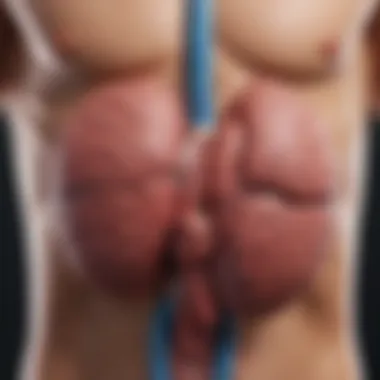

Diagnosis of Liver Cancer in Cirrhotic Patients
Diagnosing liver cancer in patients with cirrhosis can be an intricate process. The risk is heightened due to the ongoing liver damage that cirrhosis brings, making early detection crucial. Clinicians need to be vigilant, as liver cancer often develops silently until reaching advanced stages. This section aims to shed light on the various diagnostic approaches employed in such cases, underscoring the importance of timely and accurate diagnosis to improve patient outcomes.
Diagnostic Imaging Techniques
When it comes to diagnosing liver cancer, various imaging modalities play pivotal roles. Let's break down the most common techniques:
Ultrasound
Ultrasound is frequently the first imaging study conducted for patients suspected of having liver cancer, particularly because of its availability and cost-effectiveness. This method uses high-frequency sound waves to produce images of the liver, and its key characteristic is the ability to quickly identify abnormal masses. Specific to cirrhotic patients, ultrasound can help discern nodules that might be indicative of malignancy.
One unique feature of abdominal ultrasound is its capability to guide certain procedures, such as biopsies, further enhancing its utility. However, while it can effectively detect larger tumors, its sensitivity diminishes for smaller lesions and can sometimes yield false-negative results.
CT Scans
Computed Tomography (CT) scans offer a more detailed view than ultrasound. They utilize X-rays taken from different angles and process them through a computer to create cross-sectional images of the liver. CT scans are particularly known for their ability to visualize the liver's blood vessels and identify metastases, if present.
The advantage of CT imaging is its capacity to differentiate between benign and malignant lesions accurately. However, one must also consider the downside; the exposure to ionizing radiation can be a concern for some patients. Moreover, in cases of large ascites common with cirrhosis, the images may become less clear, thus complicating the interpretation.
MRI
Magnetic Resonance Imaging (MRI) utilizes magnetic fields and radio waves to produce detailed images of the liver, proving particularly beneficial in assessing cirrhotic tissue changes and in cases of suspected liver cancer. The key characteristic of MRI is its high soft-tissue contrast, which allows for superior visualization of lesions and abnormalities compared to CT and ultrasound.
One unique feature of MRI is the use of specific contrast agents that can enhance the visibility of liver tumors. While MRI is excellent for diagnostic purposes, its disadvantages lie in its high cost and limited availability at some medical facilities, making it less accessible than the other imaging options discussed.
Biopsy Practices
In certain cases, establishing a definite diagnosis requires obtaining tissue samples. Biopsies, while invasive, can provide definitive proof of cancer presence. The process generally involves guided techniques, often via ultrasound, where a needle is inserted into the liver to remove a small tissue sample. The advantage is the ability to confirm malignancies, yet risks include bleeding or infection, particularly in patients with compromised liver function.
Blood Tests and Biomarkers
Alpha-Fetoprotein Levels
Alpha-fetoprotein (AFP) is a protein that is often high in patients with liver cancer. Testing AFP levels is straightforward and can serve as a helpful screening tool. The key characteristic here is that elevated AFP levels can indicate a possible malignancy in cirrhotic patients. However, not all liver cancers will increase AFP levels, which brings limitations to its reliability as a sole diagnostic measure.
The unique aspect of AFP testing is its non-invasive nature. Despite being beneficial, false positives may arise due to other liver conditions, including hepatitis or cirrhosis itself. Thus, it cannot definitively confirm cancer without accompanying diagnostic imaging.
Liver Function Tests
Liver Function Tests (LFTs) are a battery of blood tests that assess how well the liver is working. In the context of liver cancer diagnosis, these tests can help gauge overall liver health and identify potential dysfunction. Key characteristics include measuring enzymes and other substances that may signal underlying issues.
The advantage of LFTs is their ability to provide preliminary information about liver function quickly. However, the results can be influenced by various factors, including medications and other medical conditions, leading to potential misinterpretations in the context of cancer diagnosis.
By utilizing a blend of imaging techniques, biopsy practices, and blood tests, clinicians can establish an accurate diagnosis of liver cancer in patients with cirrhosis. The integration of these methods not only aids in confirming suspected malignancies but also informs treatment approaches tailored to individual patient needs.
Therapeutic Approaches for Cirrhosis and Liver Cancer
The importance of therapeutic approaches to manage both cirrhosis and liver cancer cannot be overstated. Addressing these conditions effectively can significantly alter the quality and duration of life for affected individuals. As cirrhosis progresses, the likelihood of developing liver cancer increases, making management techniques crucial not only for treating existing conditions but also for preventing further complications. Each approach must be tailored, taking into account the specific characteristics of the patient’s condition, as well as their overall health status.
Treatment Modalities for Cirrhosis
Medications
Medications serve as a cornerstone in managing cirrhosis, especially in cases where underlying causes can be addressed. For instance, antivirals can halt the progression of hepatitis-induced liver damage and, consequently, the progress of cirrhosis. A key characteristic of these medications is their ability to slow down the liver's deterioration, allowing patients to maintain a more stable health status. While these drugs can lead to significant improvements, they may also come with side effects that need to be monitored closely, necessitating regular consultations with healthcare providers.
Lifestyle Modifications
Lifestyle modifications play a pivotal role in the management of cirrhosis. Adjustments such as adhering to a balanced diet, regular exercise, and cessation of alcohol intake are fundamental. These modifications can enhance liver function and improve the patient's overall wellbeing. Moreover, a significant benefit of lifestyle changes is that they empower patients, allowing them to take an active role in their health management. However, the challenge lies in the ease of adoption of these changes, often requiring robust support systems.
Liver Transplantation
In severe cases of cirrhosis, liver transplantation emerges as a viable but complex solution. The primary benefit of a transplant is the potential to restore normal liver function, thereby dramatically increasing survival rates. A unique aspect of liver transplantation is the need for strict eligibility criteria and a comprehensive evaluation process, which can be daunting for patients. On the downside, the waiting period for a suitable donor can be lengthy and unpredictable. This method must be considered carefully, as the complexities involved are substantial.
Cancer Treatments
Surgical Resection
Surgical resection is often seen as the gold standard for localized liver cancer that has not spread beyond the liver. The key feature of this approach is its potential to completely remove tumors, offering the chance for a cure. However, the surgery itself is not without risks, particularly for patients with underlying cirrhosis, as their liver function may impede recovery. The decision to pursue surgical options must be made with a multidisciplinary team to tailor the approach appropriately.
Radiofrequency Ablation
Radiofrequency ablation (RFA) offers a minimally-invasive alternative to surgical resection, particularly for patients who are not optimal candidates for surgery due to cirrhosis. The treatment involves using heat generated from radio waves to destroy cancerous cells. This technique is advantageous due to its lower risk of complications and quicker recovery time compared to traditional surgery. However, the limitation lies in its effectiveness for larger tumors, and careful patient selection is crucial to optimize outcomes.
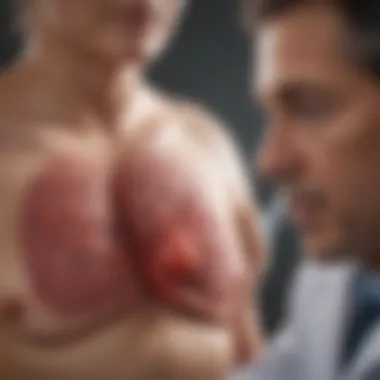

Chemotherapy
Chemotherapy can play a role, especially in cases where cancer has metastasized or is not resectable. The primary advantage of this treatment is its systemic approach, targeting cancer cells throughout the body. The downside is the potential for significant side effects, which can impact the patient's quality of life. This treatment should be considered as part of a larger tailored plan, factoring in the unique challenges posed by cirrhosis.
Targeted Therapy
Targeted therapy is a newer approach that specifically attacks cancerous cells based on certain characteristics, often causing less collateral damage than traditional chemotherapy. This method can be particularly appealing as it has been associated with fewer side effects. However, targeted therapies are not universally effective and often depend on specific genetic markers present in the tumors. This necessitates prior genetic testing, which can delay treatment but is essential for maximizing benefits.
In summary, the therapeutic approaches for cirrhosis and liver cancer are diverse and should be considered carefully. Individualized treatment plans, founded on the latest research and tailored to the patient's needs, can offer the best chance for improved outcomes.
Maintaining a dialog between healthcare providers and patients is fundamental. This ensures all parties are aware of the available options and can make informed decisions together.
Cirrhosis Management to Prevent Liver Cancer
Managing cirrhosis is not just a crucial aspect of treating existing liver damage but also an essential step in preventing the onset of liver cancer. Uncontrolled cirrhosis heightens the risk of liver malignancies due to the extensive cellular changes that occur within the liver tissue. By fostering an environment that supports liver health through proactive management strategies, patients can significantly reduce the chances of developing cancerous cells.
Understanding how to tackle cirrhosis effectively involves several critical approaches including regular monitoring, lifestyle adjustments, and potentially vaccinations that can mitigate viral hepatitis—one of the key players in liver cancer development.
Regular Monitoring and Screening
Regular monitoring and screening for liver cancer are fundamental in the management of cirrhosis. Early detection can make a world of difference, as liver cancer often progresses quietly. Patients with cirrhosis are advised to undergo periodic liver ultrasounds along with blood tests to measure alpha-fetoprotein levels, a cancer marker. This allows for timely intervention should any signs of malignancy arise.
"Routine check-ups can provide a safety net, catching issues before they spiral out of hand."
Additionally, monitoring liver function tests is crucial to assess the liver’s health and functional status. Knowing one’s liver condition can guide appropriate management strategies to lower cancer risks.
The Role of Vaccination
Vaccination plays a pivotal role in preventing liver-related diseases, particularly those stemming from viral infections. Vaccines help safeguard the liver, particularly in patients affected by cirrhosis.
Hepatitis B Vaccine
The Hepatitis B vaccine is an effective tool in protecting against liver infection that can lead to cirrhosis and subsequent liver cancer. This vaccine is known for its high efficacy rate, creating immunity against the virus.
One key characteristic of the Hepatitis B vaccine is its ability to provide long-lasting protection, typically requiring only a three-dose series to ensure immunity in most individuals. This feature renders it a favorable choice for patients with any form of liver disease, including cirrhosis.
The unique aspect of the Hepatitis B vaccine is its role in preemptively addressing one of the prime risk factors for liver cancer. While it is generally well-tolerated, minor disadvantages such as possible side effects—like soreness at the injection site—are trivial compared to the environmental shield it creates against serious diseases.
Hepatitis Treatment
Similarly, Hepatitis C is another virus linked to the development of cirrhosis and liver cancer. Recent advancements in treatment have highlighted the significance of effective Hepatitis C therapy for cirrhotic patients. Direct-acting antiviral agents represent a critical evolution in Hepatitis C treatment, achieving high cure rates.
One key characteristic of Hepatitis C treatment is its short duration, often allowing for successful treatment within eight to 12 weeks. This emphasis on prompt treatment is vital since it not only curtails the viral load but also prevents the progression towards cirrhosis and lowers the cancer risk.
The unique benefit here lies in the reduced risk of long-term liver complications post-treatment. Nonetheless, the accessibility to these treatments can sometimes be limited based on healthcare systems and patient circumstances.
Future Directions in Research
Innovations in Early Detection
The future of liver cancer management relies heavily on innovative strategies for early detection. Current methods like ultrasound and CT scans have laid a solid foundation, yet researchers are exploring more sensitive techniques. For instance, liquid biopsies are coming into the spotlight. This involves analyzing blood samples to identify circulating tumor DNA. By catching cancer cells at the first signs, there’s a chance to intervene before the disease escalates.
In tandem, the development of advanced imaging technologies, such as contrast-enhanced ultrasound, promises to enhance visualization of liver structures and functions. Through refined imaging, practitioners can discern small lesions or tumors that could be early indicators of liver cancer. Such improvements mean that clinicians could diagnose liver cancer at a stage where treatment could be more effective.
Furthermore, biomarkers are another area to watch. Research is ongoing to discover novel blood-based markers that may accurately predict liver cancer in cirrhotic patients. Monitoring changes in the levels of specific proteins could yield critical clues, possibly leading to personalized treatment strategies. Advancements like this emphasize the need for a multidisciplinary approach spanning pathology, genetics, and imaging.
"Early detection significantly shifts the management of cirrhosis-related liver cancer. It transforms the narrative from palliative care to active intervention."
Emerging Therapies
As scientific progress accelerates, therapies for liver cancer are evolving too. One of the most noteworthy avenues is immunotherapy, which has shown promise in various cancers. Engaging a patient’s immune system to target and eliminate cancer cells offers new hope. Therapies like checkpoint inhibitors, which have already made headway in other cancers, are being investigated for their efficacy in liver cancer.
Additionally, personalized medicine is starting to take root. With the help of genetic profiling, researchers aim to identify which patients are most likely to respond to specific treatments. This tailored approach stands in stark contrast to traditional methods, focusing on one-size-fits-all therapies. An individualized plan can mean the difference between successful treatment and ineffective interventions.
Combination therapies are also gaining traction. Pairing immunotherapies with targeted therapies or traditional chemotherapeutics could cover multiple angles of attack against cancer. This multidimensional battle plan may increase the chances of terrorizing resistant cancer cells that thrive amid existing treatments.
The End
Summary of Key Points
Throughout the exploration of this topic, several key points emerge:
- Cirrhosis as a Precursor: Cirrhosis significantly elevates the risk of liver cancer. The inflammatory, regenerative environment created by cirrhosis is conducive to malignant transformation.
- Mechanisms Linking Cirrhosis and Cancer: Factors such as chronic inflammation and genetic mutations play central roles in how cirrhosis can lead to liver cancer.
- Diagnostic Challenges: Detecting liver cancer in patients with cirrhosis poses unique challenges, requiring advanced imaging and biomarker assessment for timely diagnosis.
- Prevention and Monitoring: Regular monitoring of liver health and vigilant screening can mitigate the risk of cancer development in cirrhotic patients.
- Emerging Therapeutics and Research: As research advances, new therapies and early detection strategies are on the horizon, promising improved outcomes for those affected.
The Importance of Awareness
Awareness is paramount. Educating patients about the risks associated with cirrhosis, the importance of regular check-ups, and understanding symptoms can have life-altering effects. Armed with knowledge, patients can participate actively in their own care, making informed decisions that can lead to better health outcomes. Healthcare providers play a crucial role in this regard by fostering discussions about liver health, facilitating screening processes, and advocating for preventive measures such as vaccinations against hepatitis B.
"Awareness can be the difference between life and death in the context of cirrhosis and liver cancer—detection can turn the tide."
In summary, acknowledging the strong link between cirrhosis and liver cancer is essential for effective patient management. The insights provided in this article underline not just the medical aspects of this relationship but also the significant human element—empowering patients through knowledge and vigilance.



